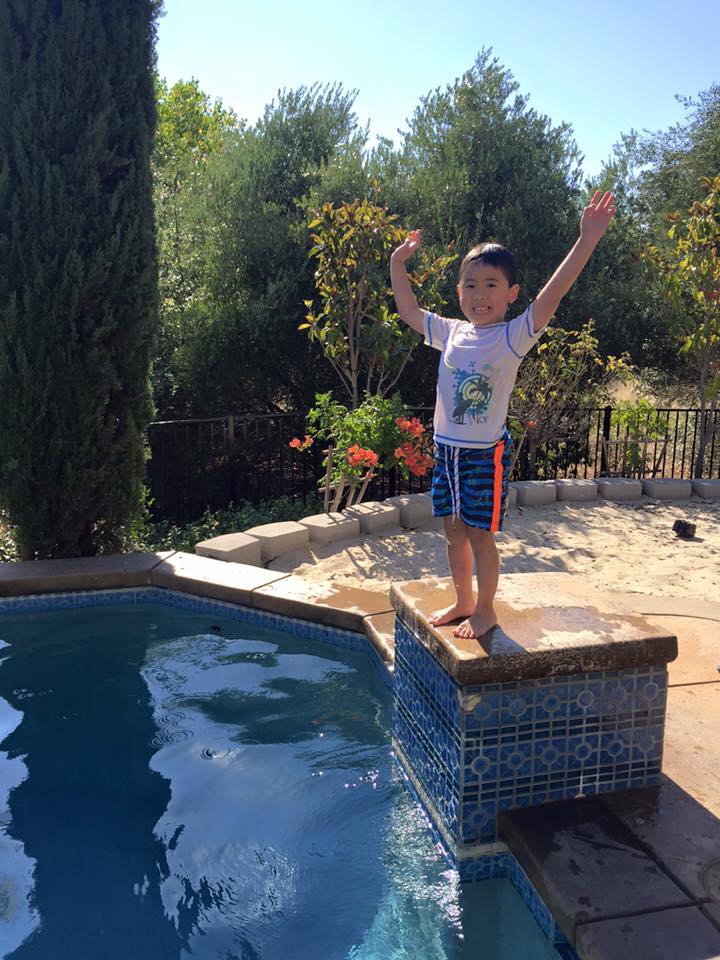
Below is the first in a series of how to practice and progress skills with children between 1 and 2 years old. These strategies apply to older students as well, but were specifically written with this age group in mind.
I give goals below, but we shouldn’t rush to meet them. Instead, we want to focus on creating opportunities for our child to build on what he knows using incremental steps. Getting in flows directly into blowing bubbles, kicking, and getting out. We will talk about how to connect activities throughout this series.
Now let’s turn our focus to getting in and how tiny steps can lead to huge progress.
Getting in
Long-term goal: child jumps in, goes under, and kicks up by herself.
Start where you left off
How should you get in? Start with the way you’re using right now before shifting to anything mentioned below. Just be sure to end each pool time by climbing out and getting in. Then repeat. Repetition gives the child a chance to process new sensations and feelings. Our goal is to help her build confidence and to find the fun.
Don’t stop
Regardless of how you get in, don’t stop. That is, the getting in moves directly to pulling the child forward encouraging her to blow bubbles and kick as you travel together.
Old Way, New Way
How do we introduce change? Start with the Old Way of getting in. Repeat. Then introduce a challenge. See if your child is ready to meet it. Repeat at least three times to let them work through their resistance. Give him a chance to become comfortable with the New Way. Praise their involvement and resistance. Help him navigate it. Help him recognize when he’s ready to move on. However, remain open to the idea that he may not be ready yet.
Big challenges, tiny steps
We want each change we introduce to be very, very small. Even so, it’s likely to feel like a big challenge to our children and our students. Let’s look at a typical series of adjustments.
By the torso
Pretend it’s day one. Carry your child into the pool. Sit her on the wall in front of you. Place your hands on her torso under her arms in a warm, nurturing way. Then use your hold to bring her off the edge and into the pool with you. Move backward with a bounce in your step, but face partly submerged so you can blow bubbles as you move across the surface with her.
By the hand
What is the point of moving to the hands? First, we want the child to experience the sensation of falling or dropping into the pool since that’s what he will experience when he jumps in on his own. Second, we want to increase the distance between us to start giving him room to move on his own.
So: Carry him into the pool. Sit him on the edge. Take hold of his hands. Then ease him forward into the pool. Pull him forward through the water by the hands blowing bubbles as you go. Strong glides will encourage him to kick. Encourage them with your words as well. Move back the wall and repeat.
Add some space
Little by little, add some space between your hands so your child will have to lean forward to reach your hands. Gradually increase the space between you until her reach brings her into the pool independently. Some children will spontaneously stand and jump in at this point. If that happens, go with it but then get out and model it for him. Emphasize that we jump out, away from the wall, when we jump in to keep ourselves safe.
In with you
At any point, you can have your child come in with you. Sit him in your lap. Wrap one arm around his belly in the safety position. Use the other arm to ease you and your child into the pool. You can stand, bounce, or go under together. We will discuss going under water in our next blog.
Catch with hands
Her jump may start right from the side. However, if it doesn’t, you can encourage it with a toss. How? Lift your child by the torso from the edge, then give her a small toss into the air before catching her—while at the same time you ease toward the surface of the pool. Your catch should make a splash. You can also encourage jumping by jumping in yourself or jumping in with them.
The rewarding drop
Some children enjoy being dropped in the pool as well. Make sure the drop happens far from the edge and is only used as a reward—that is, that it is something fun for the child.
Catch in your lap
After your child is comfortable with jumping from the edge into your arms, gradually soften your catch until he is landing in your lap. As he becomes comfortable landing in your lap, guide him toward a soft landing on your legs. Then push up with him to give them the feeling of kicking up. Gradually soften your soft landing until he is landing in the water in front of, but not on top of you. Lastly, over time, increase the distance until he is jumping in by himself.
Progress
Progress is not smooth and linear. You child may get “stuck” for weeks, then bound ahead in several unexpected jumps. When she’s stuck, continue to introduce new ideas, try new modifications. If her resistance is firm, back off, and try something different later on a different day.
Timeline
There is no set timeline for this sequence. Some children go through the sequence in a year. Some in a day. It requires our best judgment and deepest affection to find the right balance between helping a child work through his resistance and progress. Expect and respect resistance but don’t let that prevent you from helping your child push through moments of discomfort and fear. The environment of the water is peculiar. There are things about it that are uncomfortable and unfamiliar. It will not be a place where every child feels equally at home or equally at ease. Give your child the time she needs to make sense of those sensations.

About the Author: Robert Rogers
Robert is a Sunsational Swim Instructor in Santa Rosa, California.
In his work life, Robert has taught people how to sing, act, and swim—and birds how to fly. Okay, well not exactly. But he did train birds for shows at state fairs, zoos, and Disney’s Animal Kingdom. His only regret is not having learned how to fly himself—yet! You have to crawl before you can fly—or butterfly, right? Favorite animal movie of the moment: EIGHT BELOW!
Book your lesson with Robert or any of our swim instructors!
ABOUT SUNSATIONAL SWIM SCHOOL
Sunsational Swim School is the 🥇 #1 rated provider of private, at-home swimming lessons in America. We have specialized swim instructors for students ages 6 months to adult, beginner to advanced. Featured on ABC, CBS, Impact 100, The List and others, Sunsational instructors have a minimum of 2 years of teaching experience, are CPR certified and insured, and have collectively taught over 302,223 lessons for more than 74,415 students nationwide!

